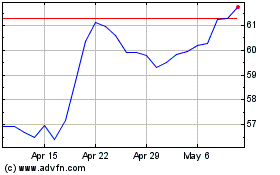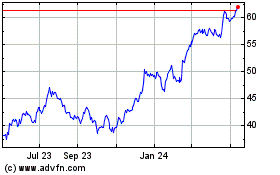Americans Optimistic About the Economy, Finances and the Future
December 18 2014 - 10:00AM
Business Wire
Generations are united by optimism and strong
desire to learn more money management skills in 2015
Americans will ring in the new year feeling optimistic about the
economy, their personal financial situation and the future of the
economy, according to the second installment of the Wells Fargo
& Company (NYSE:WFC) “How America Buys and Borrows” survey.
More than three-quarters of Americans (78 percent) expect the
economy to stay the same or improve and 81 percent believe their
current personal situation is stable or improving. This optimism is
reflected in similar levels across all generations, along with an
overall desire to learn more about money management with fewer than
half (43 percent) of respondents saying they know enough.
“Often when we talk about generations, we talk about how
different they are,” said Gary Korotzer, executive vice president
with Wells Fargo’s Consumer Credit Solutions group. “What we see in
this survey is remarkably similar levels of optimism across the
generations, led slightly by Millennials, and a united desire to
continue learning how to be better money managers.”
When asked about their view on the current state of the economy,
79 percent of Millennials (ages 18 to 32) say it is stable to
strong, which is in line with the 75 percent of Generation X (ages
33 to 48) and 70 percent of Boomers (ages 49 to 65) who say the
same thing. In addition, when asked about their expectations for
the future of the economy, 85 percent of Millennials expect it to
stay the same or get better, which is similar to the 80 percent of
Generation X and 74 percent of Boomers with the same
perception.
When it comes to personal financial situations, 84 percent of
Millennial respondents characterize theirs as stable to strong,
similar to the 81 percent of Generation X and 78 percent of Boomers
who say the same. Looking ahead, 94 percent of Millennials say they
expect their personal financial situations to stay the same or get
better with 92 percent of Generation X and 86 percent of Boomers
feeling the same way.
Optimism also encompassed the topic of homeownership, with 71
percent of respondents saying they envision being homeowners five
years from now.
“These levels of optimism are heartening, as is the desire to
continue learning the skills needed to make these positive outcomes
a reality,” added Korotzer. “More than three-quarters of
respondents said they have an appetite to learn even more, which is
encouraging because understanding how to manage money is the
foundation of financial stability and success.”
The survey also revealed:
- Millennials are most interested in
increasing their financial know-how, with 38 percent reporting a
desire to learn more – compared to 29 percent of Generation X and
30 percent of Boomers.
- In particular, more than half of
respondents (56 percent) say they would like to learn more about
managing their money, 4 in 10 feel more knowledge would increase
their confidence in decision-making and 4 in 10 aren’t fully
confident they know enough to make good decisions about
borrowing.
- According to the survey, when
respondents graded their understanding and management of money:
- 33 percent grade their understanding of
personal finances a C, D or F
- 39 percent grade their understanding of
how credit scores work a C, D or F
- 43 percent grade their understanding of
credit and loan products a C, D or F
- 43 percent grade their understanding of
what banks consider when approving a credit product or loan a C, D
or F
- 75 percent of respondents say having a
good credit score is important, yet only 54 percent say they are
proud of their credit score and 37 percent are concerned about
their credit score.
- 56 percent believe a person’s credit
rating is a reflection of how responsible they are with money and
45 percent regularly monitor their credit report.
- Half of respondents agree that having
some debt is normal. However, one-third say they live debt-free,
half say they do not carry a credit card balance and half save for
major purchases instead of relying on credit.
- Consumers are improving their financial
situations. For example:
- 38 percent report having less debt now
than they did two years ago – a slight increase over the 36 percent
of respondents saying the same in last year’s survey.
- 38 percent say that if they lost their
jobs, they would be able to get by for at least a few months. In
last year’s survey, only 32 percent of respondents indicated this
level of preparedness.
- 31 percent of respondents are saving
more today than they were five years ago. In 2013, only 28 percent
of respondents responded similarly.
- 27 percent feel prepared for unexpected
expenses and emergencies. In 2013, only 21 percent of respondents
felt prepared.
- Most respondents (81 percent) reported
the need to plan for significant expenses in the next couple of
years. The most common expenses mentioned were travel (35 percent),
taxes (35 percent) and home improvement (30 percent).
- Most prefer to fund their significant
expenses with cash savings, instead of credit. Exceptions:
specific-purpose loans such as a mortgage, auto, or student and
personal loans for the purpose of debt consolidation.
- Most feel that there are different
kinds of debt, with 52 percent of respondents saying owing money on
a mortgage is not the same as owing money on other types of
purchases.
- Millennials are more likely than older
consumers to consider a student loan an investment.
- On average, respondents believe their
current homes to be worth $311,000 and owe $151,000 on their
homes.
Free Tools
Understanding how to responsibly manage finances and credit are
important steps to building (or improving) and maintaining a sound
financial future. To help its customers succeed financially through
life’s various stages, Wells Fargo offers the following
complimentary tools:
- My Financial Guide, which features
articles and videos about money management.
- Hands on Banking®, an interactive
financial education program for all age groups (available in
Spanish at www.elfuturoentusmanos.com).
- Wells Fargo’s new Path to Credit video
series, designed to illustrate why credit, and understanding it, is
important to everyday life.
- My FirstHome online, which helps
first-time and ready-again buyers prepare for homeownership.
- Get College ReadySM, an interactive
platform for parents and college-bound students offering free
resources and tools to help guide students’ transition into
college.
About the How America Buys and Borrows survey
On behalf of Wells Fargo, Ipsos surveyed more than 3,000
American adults ages 18 to 65 in June 2014 online to understand
attitudes and perceptions of current economy and personal financial
situations. Weighting on age, gender, education, diverse segments
and income was applied to the results to achieve a nationally
representative population. The “How America Buys and Borrows”
survey was first conducted in 2013 and will be conducted
annually.
About Wells Fargo
Wells Fargo & Company (NYSE:WFC) is a nationwide,
diversified, community-based financial services company with $1.6
trillion in assets. Founded in 1852 and headquartered in San
Francisco, Wells Fargo provides banking, insurance, investments,
mortgage, and consumer and commercial finance through more than
8,700 locations, 12,500 ATMs, and the internet (wellsfargo.com),
and has offices in 36 countries to support customers who conduct
business in the global economy. With approximately 265,000 team
members, Wells Fargo serves one in three households in the United
States. Wells Fargo & Company was ranked No. 29 on Fortune’s
2014 rankings of America’s largest corporations. Wells Fargo’s
vision is to satisfy all our customers’ financial needs and help
them succeed financially. Wells Fargo perspectives are also
available at Wells Fargo Blogs and Wells Fargo Stories.
Photos/Multimedia Gallery Available:
http://www.businesswire.com/multimedia/home/20141218005208/en/
Wells Fargo & CompanyMedia:Kate Pulley,
917-260-1673catherine.b.pulley-dennison@wellsfargo.comNatalie
Brown, 775-689-6123natalie.m.brown@wellsfargo.com
Wells Fargo (NYSE:WFC)
Historical Stock Chart
From Mar 2024 to Apr 2024

Wells Fargo (NYSE:WFC)
Historical Stock Chart
From Apr 2023 to Apr 2024
